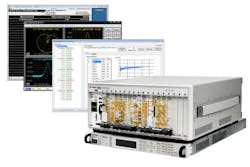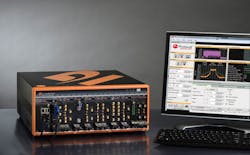As devices become more advanced, it increases the amount of necessary testing. Rising costs are thus associated with validating these new products. PXI (an acronym for PCI eXtensions for Instrumentation) was created to specifically address the challenges in the automated test industry. In comparison with traditional box instruments, PXI-based test setups can be customized with the instrumentation modules needed to meet each new test requirement. They provide complex test setups while retaining flexibility.
This file type includes high resolution graphics and schematics when applicable.
Next-generation devices have prompted suppliers of PXI-based test products to provide complete test solutions to meet the complex testing requirements of these devices. By combining modular PXI-based hardware with measurement software, these test solutions provide comprehensive results with benefits in test time and cost.
Power-Amplifier Test Solutions
The LTE and IEEE 802.11ac wireless standards are being deployed across the globe. Although these new standards offer a number of benefits, they also create additional test challenges. In the case of the RF power amplifier (PA), engineers must take these standards into account to meet performance requirements. Because of these standards, PAs are becoming more complex, thus significantly increasing testing requirements.
The LTE and IEEE 802.11ac standards both use wider bandwidths and offer faster data speeds than earlier standards. These newer wireless standards must employ advanced modulation schemes and signal processing. Because of these techniques, stringent linearity and efficiency requirements are placed on the PA. Digital pre-distortion and envelope tracking are popular techniques used to improve PA linearity and efficiency, respectively. However, these technologies also require additional test capabilities.
Minimizing distortion is a key challenge when designing a PA. Digital pre-distortion is a signal-processing technique used to improve a PA’s linearity, thereby reducing distortions. The PA’s input signal is intentionally distorted to compensate for the distortion generated by the PA itself. This pre-distorted input signal produces an undistorted signal at the PA’s output, thus improving the PA’s linearity. Digital pre-distortion algorithms can be grouped into three broad categories: look-up table, memoryless polynomial, and polynomial with memory. Digital pre-distortion is used in many PA chipsets to improve linearity.
Envelope tracking is a popular technique used to improve a PA’s efficiency. The envelope-tracking technique dynamically adjusts the PA’s dc supply voltage to track the instantaneous amplitude of the PA’s input signal. Thus, higher voltages are delivered to the PA only when needed, improving battery consumption and heat dissipation. Envelope tracking is expected to become a standard feature in LTE phones. In the case of IEEE 802.11ac implementations, envelope tracking is also gaining interest.
With PAs becoming more complex, test setups must provide solutions to accommodate the increased testing requirements of these devices. Specifically, the increased amount of PAs implementing digital pre-distortion and envelope tracking forces test setups to have the capability to support these techniques. Suppliers of PXI-based test products are offering solutions to provide the testing required in support of these technologies. These test systems are intended to provide automated testing capabilities for high-volume production test environments. With its PA test solution, National Instruments (NI) is one company that offers PXI-based testing solutions to meet the needs of these PAs.
“NI’s test system enables engineers to solve difficult PA test challenges like automating testing of digital pre-distortion and envelope-tracking PAs,” said David Hall, the company’s principal product marketing manager. “Our test system provides solutions for digital pre-distortion and envelope tracking through a software experience that automates all of the necessary instruments. These instruments include NI’s vector signal transceiver, arbitrary waveform generators for envelope-tracking testing, power supplies, a digital I/O module, and a high-speed oscilloscope. In the case of engineers who want to automate envelope-tracking/digital pre-distortion PA testing over multiple frequencies or power levels, the test system provides a series of open-source LabVIEW examples that can be easily modified.”
The test system can be configured with National Instruments’ standard PXI instrumentation. The NI PXIe-5646R vector signal transceiver combines a vector signal generator and a vector signal analyzer into one module. With a bandwidth of 200 MHz and a frequency range from 65 MHz to 6 GHz, the NI PXIe-5646R is well suited for PA testing. Additional products include the NI PXIe-5451 arbitrary waveform generator, the NI PXIe-4139 precision source measure unit, the NI PXIe-5162 10-bit digitizer, and the NI PXIe-6556 high-speed digital I/O module.
Further explaining the digital pre-distortion and envelope-tracking capabilities offered by the test system, Hall noted: “In the case of digital pre-distortion testing, the system performs basic PA model extraction using the vector signal transceiver. By extracting a model of the PA, the system’s software can implement a range of digital pre-distortion models, including a memoryless look-up table and multiple memory polynomial models. In the case of envelope-tracking testing, the solution uses information regarding the instantaneous power of the waveform, as well as a look-up table, to provide a modulated power supply by means of an arbitrary waveform generator. One of the benefits of using PXI for envelope-tracking testing is that all PXI modules can be tightly synchronized. In fact, tight synchronization between the arbitrary waveform generator and vector signal generator is an essential requirement for envelope-tracking PA testing.”
For its part, Keysight Technologies is addressing the challenges of testing next-generation RF power amplifiers/front-end modules (PAs/FEMs). Keysight’s PXI-based PA/FEM reference solution is intended to be used for both the design validation and production testing of these next-generation devices (Fig. 1). The PA/FEM reference solution combines hardware and software to provide a complete architecture.
“Greater demands for longer battery life and improved data throughput for wireless devices are creating challenges,” said Steve LaCourse, wireless solutions program manager at Keysight. “Designers and test engineers must find new approaches to address linearity, bandwidth, and power efficiency in wireless components. These designers and engineers are challenged to improve the efficiency of the RF PA, which is one of the largest power consumers in wireless devices.”
LaCourse added: “As the RF PA now supports multiple modes, frequency ranges, and modulation formats, there is more to test—thousands of tests are not uncommon. Techniques like digital pre-distortion and envelope tracking are often employed to help linearize the PA and increase its power efficiency. But these techniques only add complexity and additional tests, which further slows the design and test process. Envelope tracking, digital pre-distortion, and other techniques are being offered as part of a reference solution for RF PA/FEM characterization and test. The reference solution combines both Keysight and non-Keysight hardware with software to provide optimized speed and performance. The new M9451A PXIe measurement accelerator, an FPGA processing card, was recently added to make envelope tracking and digital pre-distortion characterization even faster.”
This PA/FEM reference solution enables full characterization of next-generation PA modules, providing the capability to perform a wide range of measurements. S-parameters, demodulation, power, adjacent-channel-power (ACP), and harmonic distortion can be measured with the PA/FEM reference solution.
The reference solution consists of several of Keysight’s PXI test instruments. The configuration includes the M9381A vector signal generator, the M9391A or M9393A vector signal analyzer, M937XA vector network analyzers, the M9195A digital stimulus/response module, and the M9451A measurement accelerator. The SD AWG-H3353 arbitrary waveform generator from Signadyne also is included.
The latest releases included in this solution are the M9451A measurement accelerator and the M9195A digital stimulus/response module. The M9451A measurement accelerator provides significant improvements in speed, as digital pre-distortion and envelope-tracking measurements can be made in just tens of milliseconds. The M9195A digital stimulus/response module provides 16 bidirectional input/output channels with programmable logic levels.
The PA/FEM reference solution also incorporates the recently released M937XA Series of PXI vector network analyzers (VNAs). The M937XA is a full two-port VNA that fits into just one slot. This VNA is ideal for those who simply wish to make basic S-parameter measurements. Each module is a completely independent two-port network analyzer, and as many as 16 modules can be added to a chassis. This aspect enables multiport measurements as well as simultaneous measurements of different devices.
Software is a main component of the PA/FEM reference solution. The N7614B Signal Studio for Power Amplifier Test software is a tool used for PA testing. It supports digital pre-distortion, envelope tracking, and crest factor reduction technologies.
Another example of a PXI-based PA test solution is the zSeries PA/FEM from LitePoint (Fig. 2). Optimized for testing the PAs and FEMs used in mobile devices, the zSeries PA/FEM includes the necessary hardware and software required for the characterization and testing of the latest RF front-end components.
The zSeries PA/FEM test solution’s hardware consists of a number of LitePoint’s PXI test instruments. The hardware includes the following: the zSeries 18-slot chassis; z8651 vector signal analyzer; z8751 vector signal generator; z8801 local oscillator; z8811 front-end module; z471 source measure unit; z5211 arbitrary waveform generator; z4441 digitizer/oscilloscope; z488xx RF switches/multiplexers; and the z3975 embedded controller. The z8751 vector signal generator operates from 250 MHz to 6 GHz while providing modulation bandwidth to 500 MHz. The z8651 vector signal analyzer also operates to 6 GHz with 160 MHz of instantaneous bandwidth. The test solution’s software includes a digital pre-distortion application for PA linearity characterization. The waveform creation and analysis application supports wireless standards like LTE-Advanced and IEEE 802.11ac.
Semiconductor Test System
The Semiconductor Test System (STS) from NI is a PXI-based alternative to traditional automatic-test-equipment (ATE) systems (Fig. 3). The STS combines PXI modular instrumentation with system-design software for production testing. The STS can be equipped with an RF subsystem, enabling the STS to provide fully integrated RF test capabilities.
With the RF subsystem, the STS is capable of being used as a production test platform for RF integrated circuits (RFICs). The RF subsystem is built around NI’s vector signal transceiver, which features FPGA-based real-time signal processing and control. The STS can provide S-parameter measurements for as many as 48 ports by means of an integrated port module. The TestStand software is designed to help users quickly develop and deploy test programs. With TestStand, users can develop test sequences that integrate code modules written in multiple programming languages.
PXI-based test systems are being implemented to provide complete test solutions in response to increased requirements. A range of trends, as well as the use of sophisticated technologies like digital pre-distortion and envelope tracking, are increasing the cost and complexity associated with testing the latest devices. In the case of RF PAs, as support begins for multiple modes, frequency ranges, and modulation formats, the amount of necessary testing during the design validation phase also increases. The latest PXI-based test solutions aim to provide the capability required to test and characterize next-generation devices, while providing time and cost benefits.
This file type includes high resolution graphics and schematics when applicable.




